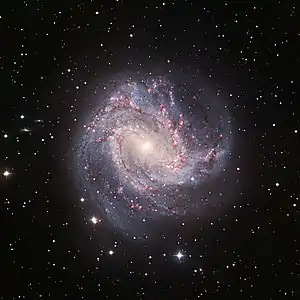| Messier 83 | |
|---|---|
 Messier 83 captured by the Wide Field Imager at ESO's La Silla Observatory in September 2008 | |
| Observation data (J2000 epoch) | |
| Constellation | Hydra |
| Right ascension | 13h 37m 00.919s[1] |
| Declination | −29° 51′ 56.74″[1] |
| Redshift | 0.001721±0.000013[2] |
| Heliocentric radial velocity | 508 km/s[3] |
| Distance | 14.7 Mly (4.50 Mpc)[3] |
| Apparent magnitude (V) | 7.6[4] |
| Characteristics | |
| Type | SAB(s)c[2] |
| Size | 36.24 kiloparsecs (118,000 light-years) (diameter; 26.0 mag/arcsec2 B-band isophote)[2] |
| Apparent size (V) | 12′.9 × 11′.5[5] |
| Other designations | |
| Southern Pinwheel Galaxy, NGC 5236, PGC 48082, UGCA 366[6] | |
Messier 83 or M83, also known as the Southern Pinwheel Galaxy and NGC 5236, is a barred spiral galaxy[7] approximately 15 million light-years away in the constellation borders of Hydra and Centaurus. Nicolas-Louis de Lacaille discovered M83 on 23 February 1752 at the Cape of Good Hope.[8] Charles Messier added it to his catalogue of nebulous objects (now known as the Messier Catalogue) in March 1781.[8]
It is one of the closest and brightest barred spiral galaxies in the sky, and is visible with binoculars.[9] It has an isophotal diameter at about 36.24 kiloparsecs (118,000 light-years). Its nickname of the Southern[lower-alpha 1] Pinwheel derives from its resemblance to the Pinwheel Galaxy (M101).
Characteristics
M83 is a massive, grand design spiral galaxy.[10] Its morphological classification in the De Vaucouleurs system is SAB(s)c,[2] where the 'SAB' denotes a weak-barred spiral, '(s)' indicates a pure spiral structure with no ring, and 'c' means the spiral arms are loosely wound.[11] The peculiar dwarf galaxy NGC 5253 lies near M83,[12] and the two likely interacted within the last billion years resulting in starburst activity in their central regions.[10]
The star formation rate in M83 is higher along the leading edge of the spiral arms, as predicted by density wave theory.[13] NASA's Galaxy Evolution Explorer project on 16 April 2008 reported finding large numbers of new stars in the outer reaches of the galaxy—20 kpc from the center. It had hitherto been thought that these areas lacked the materials necessary for star formation.[14][15]
Supernovae
Six supernovae have been observed in M83: SN 1923A (mag. 14),[16] SN 1945B (mag. 14.2),[17] SN 1950B (mag. 14.5),[18] SN 1957D (mag. 15),[19][20] SN 1968L (mag. 11.9),[21] and SN 1983N (type Ia, mag. 11.9).[22]
Environment
M83 is at the center of one of two subgroups within the Centaurus A/M83 Group, a nearby galaxy group.[23] Centaurus A is at the center of the other subgroup. These are sometimes identified as one group,[24][25] and sometimes as two.[26] However, the galaxies around Centaurus A and the galaxies around M83 are physically close to each other, and both subgroups appear not to be moving relative to each other.[27]
See also
- List of Messier objects
- M83 (band), the band named after the galaxy
References
- 1 2 Skrutskie, Michael F.; Cutri, Roc M.; Stiening, Rae; Weinberg, Martin D.; Schneider, Stephen E.; Carpenter, John M.; Beichman, Charles A.; Capps, Richard W.; Chester, Thomas; Elias, Jonathan H.; Huchra, John P.; Liebert, James W.; Lonsdale, Carol J.; Monet, David G.; Price, Stephan; Seitzer, Patrick; Jarrett, Thomas H.; Kirkpatrick, J. Davy; Gizis, John E.; Howard, Elizabeth V.; Evans, Tracey E.; Fowler, John W.; Fullmer, Linda; Hurt, Robert L.; Light, Robert M.; Kopan, Eugene L.; Marsh, Kenneth A.; McCallon, Howard L.; Tam, Robert; Van Dyk, Schuyler D.; Wheelock, Sherry L. (1 February 2006). "The Two Micron All Sky Survey (2MASS)". The Astronomical Journal. 131 (2): 1163–1183. Bibcode:2006AJ....131.1163S. doi:10.1086/498708. ISSN 0004-6256. S2CID 18913331.
- 1 2 3 4 de Vaucouleurs, G.; et al. (1991). "Third reference catalogue of bright galaxies". 9. New York: Springer-Verlag.
{{cite journal}}: Cite journal requires|journal=(help) - 1 2 Tully, R. Brent; et al. (August 2016). "Cosmicflows-3". The Astronomical Journal. 152 (2): 21. arXiv:1605.01765. Bibcode:2016AJ....152...50T. doi:10.3847/0004-6256/152/2/50. S2CID 250737862. 50.
- ↑ "Messier 83". SEDS Messier Catalog. Retrieved 30 April 2022.
- ↑ "NASA/IPAC Extragalactic Database". Results for NGC 5236. Retrieved 8 December 2006.
- ↑ "M 83". SIMBAD. Centre de données astronomiques de Strasbourg. Retrieved 29 November 2009.
- ↑ "Multimedia Gallery: M83 – Southern Pinwheel Galaxy". NASA/JPL-Caltech/WISE Team. 25 June 2010.
- 1 2 Jones, K. G. (1991). Messier's Nebulae and Star Clusters (2nd ed.). Cambridge: Cambridge University Press. ISBN 978-0-521-37079-0.
- ↑ "M 83". messierobjects101.com. 11 October 2016. Retrieved 19 April 2018.
- 1 2 Calzetti, Daniela; Conselice, Christopher J.; Gallagher, John S. III; Kinney, Anne L. (August 1999). "The Structure and Morphology of the Ionized Gas in Starburst Galaxies: NGC 5253/5236". The Astronomical Journal. 118 (2): 797–816. arXiv:astro-ph/9904428. Bibcode:1999AJ....118..797C. doi:10.1086/300972. S2CID 16296827.
- ↑ de Vaucouleurs, Gérard (April 1963). "Revised Classification of 1500 Bright Galaxies". Astrophysical Journal Supplement. 8: 31. Bibcode:1963ApJS....8...31D. doi:10.1086/190084.
- ↑ Thim, Frank; et al. (June 2003), "The Cepheid Distance to NGC 5236 (M83) with the ESO Very Large Telescope", The Astrophysical Journal, 590 (1): 256–270, arXiv:astro-ph/0303101, Bibcode:2003ApJ...590..256T, doi:10.1086/374888, S2CID 121984029
- ↑ Silva-Villa, E.; Larsen, S. S. (January 2012). "The relation between surface star formation rate density and spiral arms in NGC 5236 (M 83)". Astronomy & Astrophysics. 537: 9. arXiv:1111.1249. Bibcode:2012A&A...537A.145S. doi:10.1051/0004-6361/201117432. S2CID 119295019. A145.
- ↑ "Stellar Birth in the Galactic Wilderness". 16 April 2008. Archived from the original on 4 March 2016. Retrieved 15 December 2018.
- ↑ Dong, Hui; et al. (July 2008). "Spitzer Observations of Star Formation in the Extreme Outer Disk of M83 (NGC5236)". The Astronomical Journal. 136 (1): 479–497. arXiv:0804.3632. Bibcode:2008AJ....136..479D. doi:10.1088/0004-6256/136/1/479. S2CID 119189782.
- ↑ Transient Name Server entry for SN 1923A. Retrieved 8 July 2023.
- ↑ Transient Name Server entry for SN 1945B. Retrieved 8 July 2023.
- ↑ Transient Name Server entry for SN 1950B. Retrieved 8 July 2023.
- ↑ Transient Name Server entry for SN 1957D. Retrieved 8 July 2023.
- ↑ Romaniello, Martino; Patat, Ferdinando; Panagia, Nino; Sparks, William B.; Gilmozzi, Roberto; Spyromilio, Jason (August 2005), "Very Large Telescope FORS1 Imaging Polarimetry of M83 (NGC 5236). I. Search for Light Echoes from Historical Supernovae", The Astrophysical Journal, 629 (1): 250–258, arXiv:astro-ph/0505100, Bibcode:2005ApJ...629..250R, doi:10.1086/431470, S2CID 118978264
- ↑ Transient Name Server entry for SN 1968L. Retrieved 8 July 2023.
- ↑ Transient Name Server entry for SN 1983N. Retrieved 8 July 2023.
- ↑ Karachentsev, I. D.; et al. (2002). "New distances to galaxies in the Centaurus A group". Astronomy and Astrophysics. 385 (1): 21–31. Bibcode:2002A&A...385...21K. doi:10.1051/0004-6361:20020042.
- ↑ R. B. Tully (1988). Nearby Galaxies Catalog. Cambridge: Cambridge University Press. ISBN 978-0-521-35299-4.
- ↑ Fouque, P.; Gourgoulhon, E.; Chamaraux, P.; Paturel, G. (1992). "Groups of galaxies within 80 Mpc. II – The catalogue of groups and group members". Astronomy and Astrophysics Supplement. 93: 211–233. Bibcode:1992A&AS...93..211F.
- ↑ Garcia, A. (1993). "General study of group membership. II – Determination of nearby groups". Astronomy and Astrophysics Supplement. 100: 47–90. Bibcode:1993A&AS..100...47G.
- ↑ Karachentsev, I. D. (2005). "The Local Group and Other Neighboring Galaxy Groups". Astronomical Journal. 129 (1): 178–188. arXiv:astro-ph/0410065. Bibcode:2005AJ....129..178K. doi:10.1086/426368. S2CID 119385141.
- ↑ Its declination means every day it passes the zenith of the sky at the matching parallel of the earth, which is that of northern Argentina. It can be viewed more than an ideal 15° above the horizon for a further 75° to the north, placing such a northern limit of good observation at the 45th parallel north
External links
- Messier 83 on WikiSky: DSS2, SDSS, GALEX, IRAS, Hydrogen α, X-Ray, Astrophoto, Sky Map, Articles and images
- ESO Photo Release eso0136, An Infrared Portrait of the Barred Spiral Galaxy Messier 83
- M83, SEDS Messier pages
- Spiral Galaxy Messier 83 at the astro-photography site of Takayuki Yoshida
- M83 The Southern Pinwheel
- X-rays Discovered From Young Supernova Remnant Archived 17 June 2019 at the Wayback Machine (SN 1957D)
- Bauer, Amanda; Haese, Paul. "M83 – Southern Pinwheel Galaxy". Deep Sky Videos. Brady Haran.
- Messier 83 (Southern Pinwheel Galaxy) at Constellation Guide
